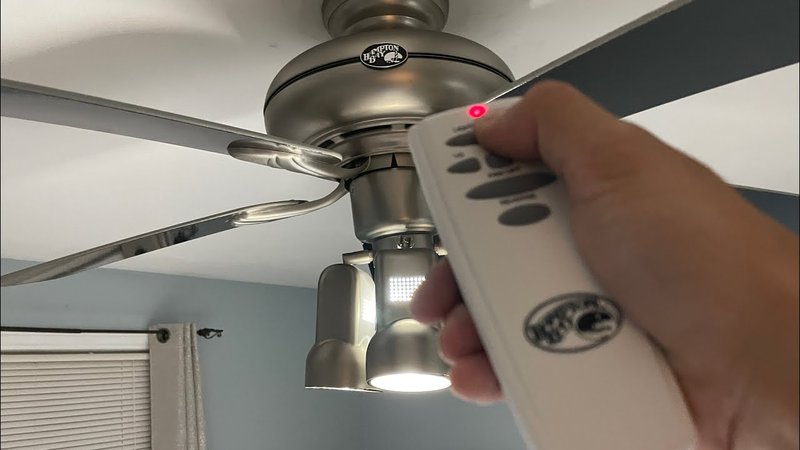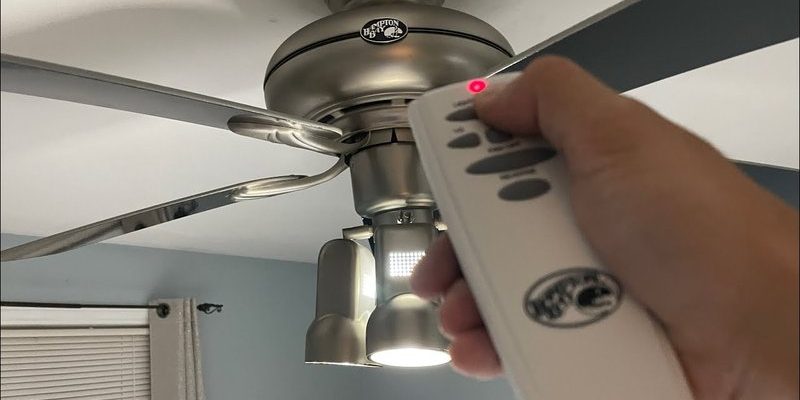
Here’s the thing: these remotes are built for convenience, but they don’t always play nice with old-school wall switches. Still, you don’t have to choose between your fancy remote and the comfort of a wall switch. With a few clear steps (and a bit of basic know-how), you can have both working together in harmony. Let me break down how these controls interact, what *not* to do, and how to keep your ceiling fan spinning—and your lights on—without any drama.
Understanding Hampton Bay Ceiling Fan Remotes and Wall Switches
It helps to picture your ceiling fan like a little orchestra. The fan itself is the musicians, the remote is your wireless conductor, and the wall switch? That’s stage lighting—important, but not always running the show. Hampton Bay ceiling fan remotes let you control fan speed, light brightness, and sometimes even direction, all without getting up from the couch. Most newer fans come with a remote included in the box, and older ones can often be upgraded with a remote kit.
But here’s where it can get tangled: your wall switch might be a simple on/off, or it might include a dimmer or speed control. If you use both at once, you might wonder who’s in charge—the remote or the switch? The answer depends on how your fan is wired. Some fans are “hardwired” to always get power unless the wall switch is off. Others have a bit more going on behind the scenes. That’s why learning exactly how your Hampton Bay remote and wall switch interact is the first step before you push a single button.
Wiring Basics: How Your Fan Gets Power
Let’s pull back the curtain for a moment. Most ceiling fans are powered through your home’s wiring, which usually runs to a wall switch. When you flip the switch, you send electricity up to the fan—simple enough. Add a Hampton Bay remote and now you’ve added a receiver (usually hidden in the fan’s canopy), which listens for your commands. This receiver needs a steady flow of power from the switch to talk to your remote.
Important: If your wall switch is off, your remote won’t work at all. The remote can only control the fan and lights when the switch is *on*. That’s why, for “remote-only” fans, people often put a piece of tape over the wall switch as a reminder not to turn it off by mistake.
If you want both controls working together, you can wire the fan so the switch supplies constant power, then use the remote for everything else. Sometimes, people install special dual-function switches, but that’s a bigger project (and honestly, most folks don’t need it). The takeaway? Your wall switch controls *power*, and your Hampton Bay remote controls the *features*. Keeping that straight helps you avoid confusion—and keeps you from accidentally resetting the remote or losing sync.
Pairing and Syncing Your Hampton Bay Remote
Let me explain how the magic happens. When you first set up your Hampton Bay ceiling fan remote, there’s a pairing process—like introducing two new coworkers so they can collaborate. Inside your remote and the receiver, there are small switches called DIP switches. These tiny toggles set a specific “code” so your remote and receiver can talk without interfering with the neighbor’s fan.
Here’s how to sync your remote with the fan:
- Turn off power at the wall switch (or circuit breaker—safety first!).
- Open the remote’s battery compartment. Look for those little DIP switches.
- Open the fan’s canopy to find the receiver—more DIP switches.
- Set both sets of switches to match the same code.
- Install batteries, turn the wall switch back on, and press a button on the remote.
If everything’s matched, your fan and light should spring to life at your command. Troubleshooting tip: If the remote isn’t working, double-check the code—or try resetting the remote and receiver by cutting power for 30 seconds, then turning it back on. Don’t forget the battery—a weak battery in the remote can throw off syncing.
What If You Lose Sync?
This happens more often than you’d think, especially after a power outage. Sometimes, the receiver loses its memory, or a neighbor’s new remote starts controlling your fan. In that case, repeat the pairing steps above. Always match the codes, and remember—power must be ON at the wall switch for pairing to work.
How To Use the Remote and Wall Switch Together
You might be wondering, “Can I turn the fan on with the wall switch and adjust the speed with the remote?” Good question. Here’s how these controls usually work side by side:
– The wall switch acts as the master power. When it’s off, everything’s off—remote included.
– Leave the wall switch always on if you prefer remote control. The fan and lights are now “live,” but only run when you use the remote.
– If you want to use both, use the switch to cut power when you leave the room for long stretches—but keep it on most of the time to avoid needing to reset or pair the remote again.
Real-life example: In my first apartment, I put tape over the wall switch and used the remote for everything. My roommate hated that, so we compromised. The switch stayed on during the day, but we’d flip it off if we left for the weekend. That way, the remote never lost sync, and the fan worked exactly when we wanted.
What About Dimmer or Multi-Speed Wall Switches?
If your wall switch has a dimmer or adjustable fan speed dial, it can interfere with remote operation. The remote receiver expects a constant, stable power supply—not fluctuating voltage from a dimmer. Using both at once can cause flickering lights or make the fan behave strangely. In this case, replace the dimmer switch with a standard on/off switch. The remote has all the speed and dimming options you need.
Resetting Your Hampton Bay Ceiling Fan Remote
Here’s where things get a little technical. Sometimes, the Hampton Bay ceiling fan remote starts acting up—buttons stop responding, or the fan refuses to change speed. Resetting both the remote and the receiver can clear up most glitches.
Step-by-step reset:
- Turn off the wall switch (or flip the circuit breaker for full power off).
- Wait at least 60 seconds—let all the electricity drain out.
- Turn the switch or breaker back ON.
- Within 30 seconds, press and hold the “Fan” or “Light” button on your remote (check your manual—different models use different buttons for pairing).
- If it works, the fan will spin or the light will blink, confirming a successful reset.
Resetting wipes out any old codes and lets you pair a new remote or receiver. If you’re still having trouble, check for a fresh battery and make sure no one’s accidentally flipped the wall switch off.
Sometimes it feels like these remotes have a personality of their own! But honestly, nine times out of ten, a quick reset fixes stubborn issues.
Troubleshooting Common Issues
Things don’t always work perfectly. Maybe the remote is unresponsive, or the fan works but the light doesn’t. Here are a few likely culprits and how to fix them:
- Dead Battery: Sounds obvious, but the battery in the remote wears out faster than you’d think. Always check it first.
- Switch Off: If someone flips the wall switch, the fan and remote lose power and connection. Make a habit of leaving the switch ON if you want the remote to work.
- Signal Interference: Other electronics or even another remote close by can scramble the code. Re-pair your remote and receiver with a unique code using those DIP switches.
- Loose Wiring: If nothing works, the receiver may have a wiring issue. Shut off power and check connections in the fan’s canopy—but if you’re not comfortable, call in a pro.
Pro tip: When in doubt, repeat the pairing/reset process slowly. Most problems come down to a lost signal or someone flipping the wrong switch.
Universal Remotes vs. Hampton Bay Brand Remotes
You might be thinking, “Can I use a universal ceiling fan remote instead?” It’s possible, but there are some trade-offs. Hampton Bay ceiling fans are designed to work best with their own remotes, since the receiver and remote “speak the same language.” Universal remotes can be paired, especially if you match the code using DIP switches, but not every function is guaranteed to work.
- Universal remotes often lack some features—like reverse or dimming—that Hampton Bay remotes include.
- Pairing with the receiver works the same way (match the codes!), but check your fan’s manual for compatibility.
- If you lose your original Hampton Bay remote, you can buy a replacement online—just make sure to sync it up with your receiver.
Bottom line: Stick to the original Hampton Bay remote when you can, but if you’re in a pinch, a universal remote might work for basic on/off and speed settings.
When to Call an Electrician
There are limits to DIY. If you open up your fan and find a mess of wires, or if nothing seems to fix your remote/receiver pairing, it’s smart to call an electrician. Also, if your home’s wiring is older (think: pre-1980s), there may be quirks that make remote-and-switch combos tricky to set up.
Your safety matters. Don’t force wires, don’t ignore buzzing or flickering, and don’t leave a hot switch taped up for months if it’s not working right. An electrician can usually sort out Hampton Bay fan wiring for remote and wall switch use in under an hour.
Quick Reference Table: Using Hampton Bay Remote and Wall Switch
| Situation | Best Practice |
| Want remote and wall switch together | Keep wall switch ON; use remote for control |
| Remote not working | Check battery; ensure wall switch ON; re-sync |
| Using dimmer wall switch | Replace with simple on/off switch |
| Lost remote | Buy Hampton Bay or universal remote, match code |
Keeping Your Hampton Bay Setup Running Smoothly
Using a Hampton Bay ceiling fan remote with a wall switch doesn’t have to be confusing. It’s all about understanding who controls what: the wall switch brings the power, and the remote handles the features. Once you’ve got your remote synced, your fan and lights will respond exactly how you want—no guessing, no frustration.
Most issues come down to a flipped switch, a tired battery, or a remote that’s lost its way. Go slow, match your codes, and make sure you’re always working safely with the power off when you’re inside the fan canopy. A little patience pays off—before you know it, you’ll be flipping on the wall switch and grabbing the remote like a pro. Enjoy that breeze.
